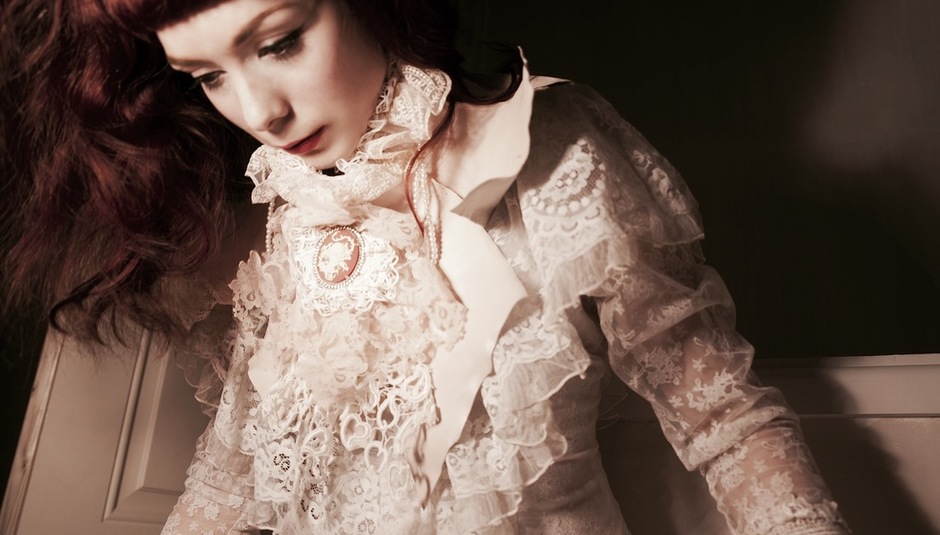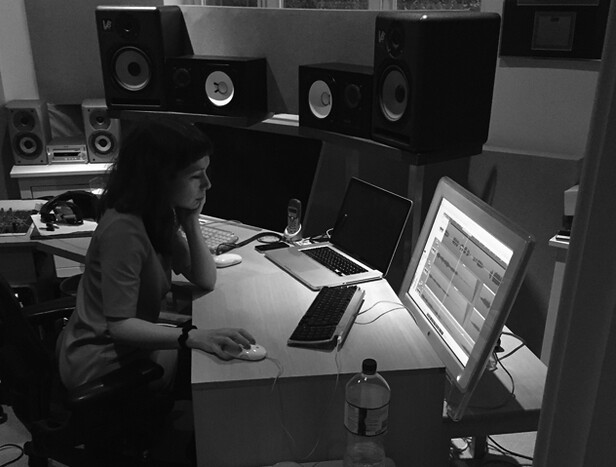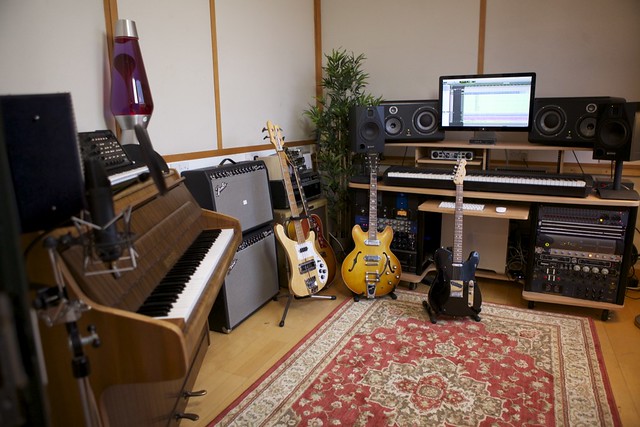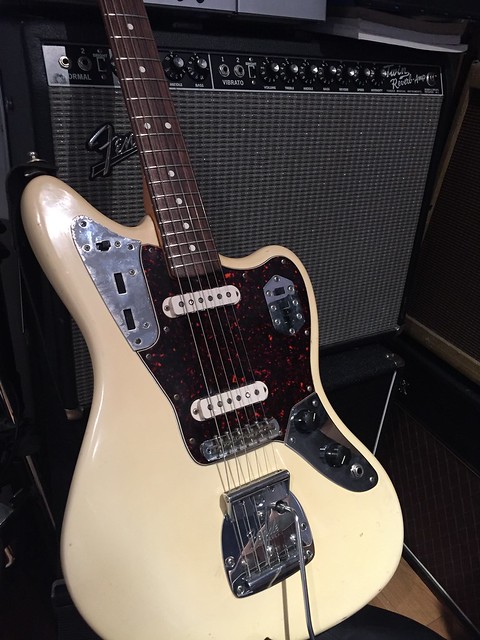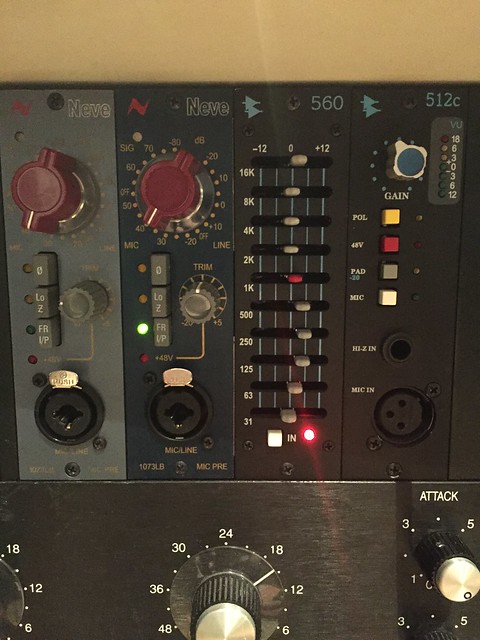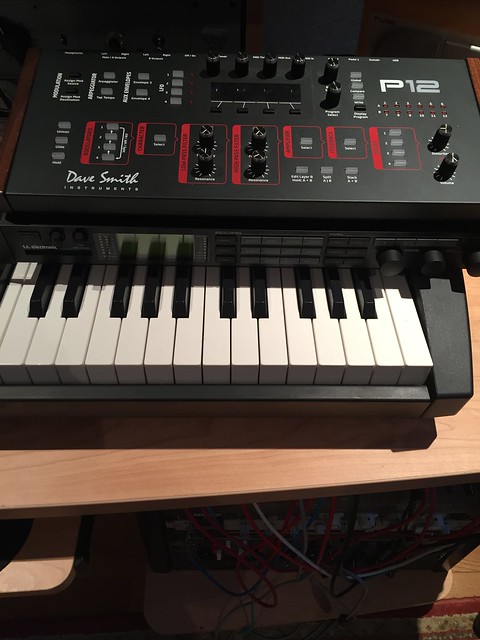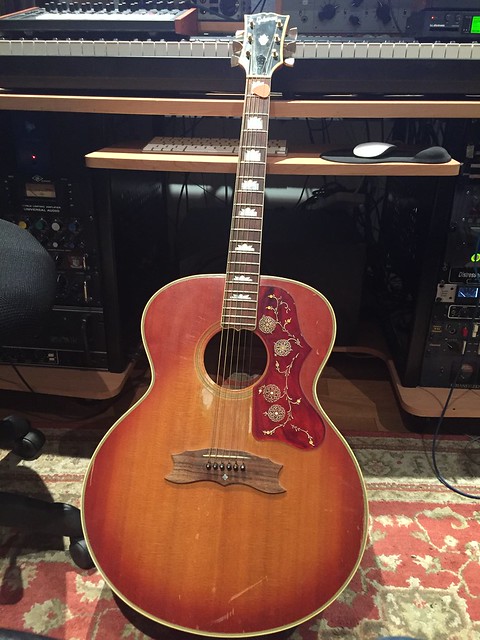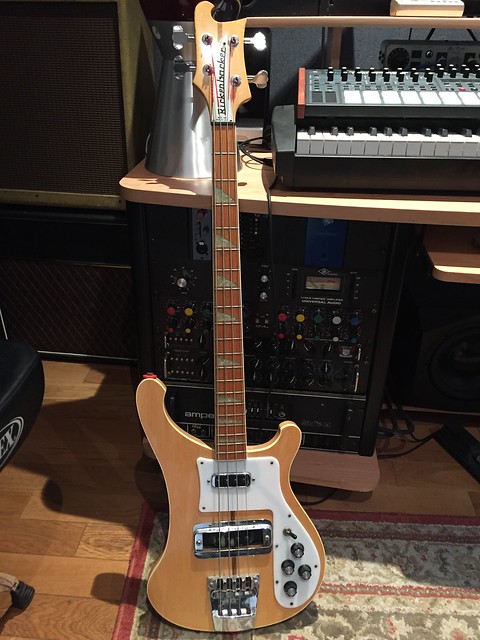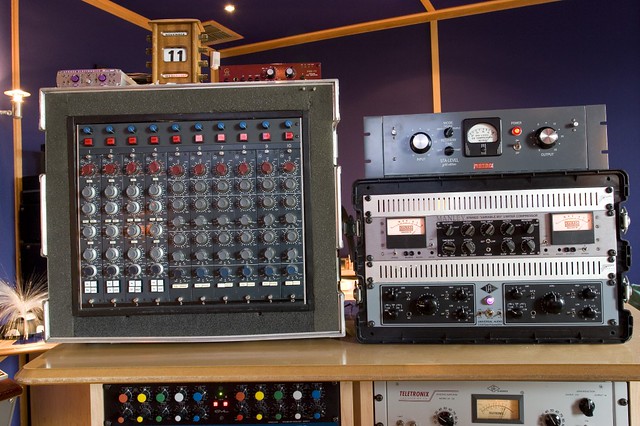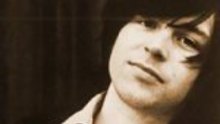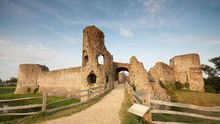Planet Gear is our semi-regular column in which we nose around the equipment that some of our favourite bands use.
In this edition, Catherine Anne Davies aka The Anchoress and ex-Mansun frontman Paul Draper give us the lowdown on the making of her debut album, Confessions of a Romance Novelist (set for release on Jan 15th 2016 through Kscope), focusing on the making of current single, 'You and Only You', which features guest vocals from Paul Draper. The track went through a mammoth six versions before arriving at its finished incarnation.
Draper helped to capture the collection of songs on which Catherine played a variety of instruments, including piano, guitar, flute, omnichord, mellotron, wurlitzer, glockenspiel, and celeste, as well as multi-tracking up to 25 vocal harmonies on some of the songs. Yet, recording was interrupted by a series of events that threatened to derail the project completely, including Catherine injuring her hand so badly during a 48-hour recording session that she was told she might not play again and had to wear a metal cast for 6 months. Or as Catherine puts it:
"This has been made on a wing and a prayer, lots of favours, one car crash, one death, one broken hand, and a lot of patience on so many parts. Stir in 3 jobs, 4 studios, 2 arrests, 3 pianos, 40 songs and 1 very patient engineer… and you get some way to understanding what a long road it has been."
Catherine: The album was the last thing recorded at Hugh Padgham's studio, Sofa Sound, before it closed its doors for the last time in February 2015. In a way, the record is a lot of firsts and lasts… It is also Paul Draper's first full-length production since Mansun's Six, with the connection between the two being that the last Mansun album (Little Kix) was also recorded by Hugh Padgham, which is how Paul ended up with a production room in Hugh’s studios complex. Sometimes it also felt like the first and last album I’d ever make too… There ended up being six versions (including alternate mixes and string arrangements) of what is now the single, 'You and Only You'. I thought it might be interesting to explain the process of just how we got to the definitive version...
Recording The Track
Catherine: After trawling through nearly a hundred demo tracks I sent Paul, we ended up going into Hugh’s Sofa Sound studio to track the bulk of the album live in a series of 2-3 day sessions over a year. Everything that formed the foundations of the album was recorded over those 10 days of live sessions, with 16 tracks in total.
For 'You And Only You', as well as the rest of the tracks that feature on the album, we recorded all the drums, bass, and piano live, with DI bass and the piano with a pair of vintage 4038 Coles microphones (we recorded so many things on the album with these beauties). I’d go in in the morning and teach Jon (drums) and Stax (bass) the songs and after playing them round a few times, we’d start recording. Although Paul and I shared production duties on the album, Paul manned the SSL desk while recording as I was playing with the band so we could get the exact takes we wanted. Guitars were overdubbed at a later stage. We used Hugh Padgham’s bank of vintage Neve pre-amps that he used for the infamous Phil Collins gated drum sound and the classic Stuart Copeland drum sound from The Police recordings.
Paul's production room was in the same building - the now defunct Stanley House complex - where we took the live recordings of the band to overdub. Paul had his vintage amplifier collection modified by Jeff Atter so all the speakers could be disconnected from the amps and plugged straight into Sequis motherload speaker simulators, and then into Paul's collection of outboard mic pre-amps before going into Protools HD system.
We worked this way once we had the live band recordings from the Sofa Sound sessions. Everything subsequently was edited and overdubbed in Paul’s production room, “The Kitchen” – a small 10' x 15' space off the studio's main kitchen. The location of the production room often meant keeping noise levels to a minimum, which we did with the use of the motherload speaker simulators for the guitars, as well as using them for re-amping the DI'd bass we'd recorded during the live performance of the drums and piano.
Vocals
Paul Draper: Catherine sung through a Neuman U87ai, of which I have a pair. This was the first serious mic I bought when I signed a record deal with Mansun and have used it ever since so it has a bit of history. It's been refurbished once and has been my workhorse condenser mic for years, though I use it less and less now. The 87 goes into my Neve 1073 which I have installed in an API lunchbox with another 1073 to make a pair for stereo recordings. This was the main vocal mic pre for this album but I have since purchased a Chandler valve REDD.47 EMI mic pre, which is the best mic pre I've ever used. After the 1073 the vocal chain went into my 1176 blackface compressor for gentle compression. I didn't squash it too much as Catherine has a wide dynamic range to her vocals and I wanted to keep that intact. I have all my outboard gear accessible at all times as they are all connected to my 2 patchbays by d-sub connectors. This gives my production room, 'The Kitchen', the feel of a proper old school recording studio as I love the analogue world.
I think of this vocal chain as my classic set up, but as the track evolved from a single vocal performance by Catherine into a duet, I began singing in my vocal part sitting in front of the desk in the control room, trying counter melodies around Catherine's main vocal part. I had the track blasting out of my Adam monitors, which I have an Adam sub connected too so I can gauge bottom end better, and sat a few feet away with a Shure SM 58 going through my Chandler TG channel mic pre with no EQ circuit kicked in and then into my Chandler TG compressor, which isn't usually used as a vocal compressor but I sometimes use it for variety. I love the TG mic pre and bought 2 as this is the mic pre Abbey Road was recorded through as part of EMI's TG recording console, in my opinion the finest ever built.
Someone can't remember the words... #bvslave
Posted by The Anchoress on Thursday, 23 October 2014
Electric Guitar
Paul Draper: The electric guitar was one of the last elements to go on this track. Initially Cenzo Townshend mixed a strings version of the track with no electric guitar except some DI'd delay guitars on the chorus which were used for a chorus build, but we took the strings out to make the track more edgy and mixer P-Dub suggested adding a main electric guitar part over the acoustic throughout the track to make the track more of a traditional guitar bass and drums arrangement. As we were working in my production room, I had my amps set up going through Sequis Motherlode speaker simulators direct into my patchbay. This allows me to use the amp stage of my valve amps but then go straight into my mic pre's without mic'ing up the amps, partly for ease of use, partly to keep the noise of the amp speakers blaring out of the room. I plugged my 15 year old USA Fender Jaguar into my Fender Twin Reverb amp which I knew would give me the spring reverb sound I thought would be good as a replacement for the original strings on this track. The Jaguar gave me the chiming tone and is a great combination with the Fender Twin. The speaker was disconnected on the Twin and the speaker out went into the Motherlode and then via my patchbay into an API 512 mic pre in my API lunchbox. There was no compression added as I rarely compress electric guitars as they're usually pretty flat dynamic wise and I didn't want to use compression as an effect.
We also went into the EQ section of my Chandler TG channel to give the amp sound some extra bite, boosting the upper mids, again patched in on the bantam patchbay. I have this set up as we can go straight into my Pro Tools rig via the amp with no noise in the production room, which was the main way we recorded guitars and bass on this album. We decided to use the motherlodes early on in the recording process to keep noise down in the building more than anything but partly for ease of use too. Only the rhythm guitar on the album track 'Long Year' was played with the amp mic’d up which we tried as an experiment and sounded great. We used a 57 close on the cab, but it was really for necessity and ease of use to keep the noise down in the production room that we used the Motherlode speaker simulators on the guitars other than that. We did some A/B comparisons of the Motherlodes vs the amp cabs close mic’d with a 57, and although there was a difference it was close enough that we went ahead and used speaker simulators for guitar and bass.
There is also a panning delay guitar on chorus 2 and 3. This was layered over half a dozen times and we used a Soundtoys panman plugin to send the guitars round the stereo spectrum. We needed a signature part to dynamically and harmonically lift the chorus and you can hear this pulsing away as a build from chorus 2.
Keyboards
Catherine: The keyboard riff came from the Dave Smith Instruments Prophet 12 module. We ended up recording this version on snatched days off while I was on a 60 date European tour with Simple Minds. I'd been listening to The Cure and The Twilight Sad a lot during this time which became quite a looming influence on this version of the track. I went through trying various sounds and ideas to find a motif that would fit the intro and various parts in the song where the arrangement needed an additional element to glue it together. This came out of the module in stereo and into a pair of Chandler TG Channels, again boosting the upper mids in the EQ section to make the sound cut through the mix and make it more aggressive than the original module sound. On the middle 8 there's a mellotron plug - the G Force MTron - that survived the arrangement cull from the first incarnation of the track. Paul use to own a real mellotron but sold it many years ago, so we made do with this virtual instrument which is pretty buried in the final mix.
Acoustic Guitar
Paul Draper: I recorded Catherine's acoustic guitar with an AKG 414 mic. This is less bright than the U87ai I had traditionally used on acoustic and I bought it for this purpose. The Gibson J200 was recorded in my production room, The Kitchen in Acton West London and the 414 went into an API 512c mic pre in my API lunchbox rack. There was no compression and this went straight into Pro Tools. We usually do about 3 takes of most things on playlists and comp from that. We practiced this part a lot to get it right with the bass.
Strings
Cooking in The Kitchen today #strings
Posted by The Anchoress on Friday, 27 June 2014
Catherine: The strings don't appear on the final radio version of the single as they were something of a victim of the evolving arrangement of the track. They do, however, make a prominent appearance in the "Cenzo Townshend String Mix" that is on the 5 track version of the EP, (alongside an alternative falsetto vocal from Paul). We recorded the strings in Sofa Sound on one of the hottest days of the year. A good friend of mine Gillian Wood arranged these for 2 violins, a viola, and cello but we only had three players so there was a certain amount of overdubbing involved, thanks to the good will of the players. Everything was close mic'd with the U87's and we also had a pair of the Coles (4038's) for the room and another pair of U87's from Hugh's microphone amourey. I spent around 3 days in Pro Tools just fine-tuning the strings due to the humidity and heat playing havoc with the tuning that day.
Rickenbacker 4001 Bass
Paul Draper: The bass used was my Rickenbacker 4001 from 1974 which I bought in New York and was put into an Ampeg SVT II amp head, then again into one of 2 Sequis motherlodes that I own. We could have tried the musicman bass Stax, our resident bass player was using on the album, but the presence of the Ric made it perfect for this track. Importantly to the sound of the track it was played with a plectrum. I fiddled with the simulator settings on the motherlode till I got the best sound I could to my ear that worked with Jon Barnett's drum pattern. The motherlode went via the patchbay and into a Chandler TG Channel mic pre and EQ. I boosted the mids a bit to make the bass a bit beefier then took it out and into a Blackface 1176 Compressor which clamped it down and made the metronomic part more solid. This chain went direct into my Avid HD I/O which is again patched into my patchbay and via my Pro Tools HDinterface into my Mac Pro and Pro Tools HD software.
Drums
As previously mentioned, in Sofa Sound, Hugh kept a rack of vintage Neve mic pre-amps that he recorded all of Stuart Copeland's drums through for the Padgham-produced Police albums. The engineers, Scott and Cesar set up Jon Barnett's Premier drum kit. We had slight EQ nudges on the snare mic but generally everything was recorded in flat. We used the Coles 4038 ribbon mic's as overheads again and 57's on the top and bottom of the snare, Senheiser 421's on both toms, and a fet Neuman 47 and AKG D112 on the kick. We also had a pzm room mic compressed heavily with a distressor. The kit sounded beautiful in Hugh's live room, however, we reinforced the snare with a sample of a Linn 9000 drum machine sitting under the main snare mics, to give the kit a contemporary feel in the final mix.
Mixing
Catherine: First time around (we ended up mixing it twice…), the album was mixed fully in the box, excepting ‘One For Sorrow’ which was mixed on Hugh's SSL which we compared with our ITB mixes, and ‘Bury Me’ which we mixed in the box and then spread out through Paul's 8816 summing mixer with an outboard SSL quad compressor which we put across the bus. It was my choice to mix in the box, which Paul attributes to my ears being "more attuned to the digital age". I say he's just f**king old and losing his hearing... ; ) We then brought in Paul “P-Dub” Walton and Cenzo Townshend to mix our recordings, and Jon Astley to master the finished album.
Confessions of a Romance Novelist is released on January 15th 2016 via Kscope. Download 3 tracks instantly when you preorder the album here.
Buy the 22 page deluxe gatefold CD here.
Buy the 5 track digital You and Only You EP here.
And you'll find plenty more Planet Gear columns here.

